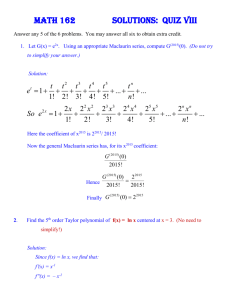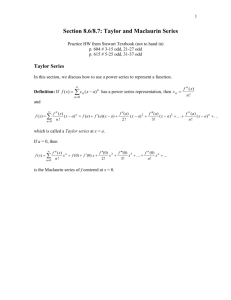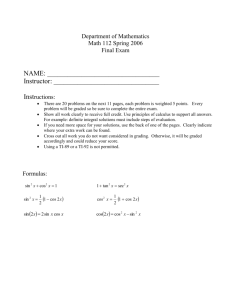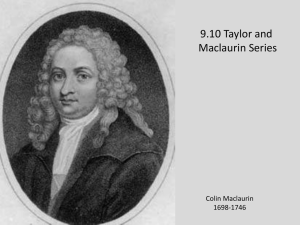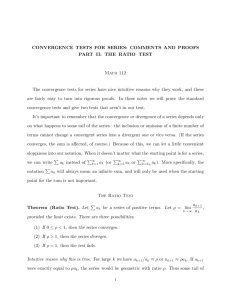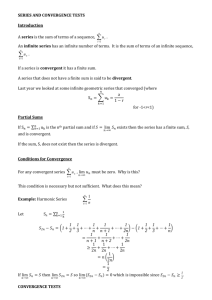Math 115 HW #5 Solutions
advertisement
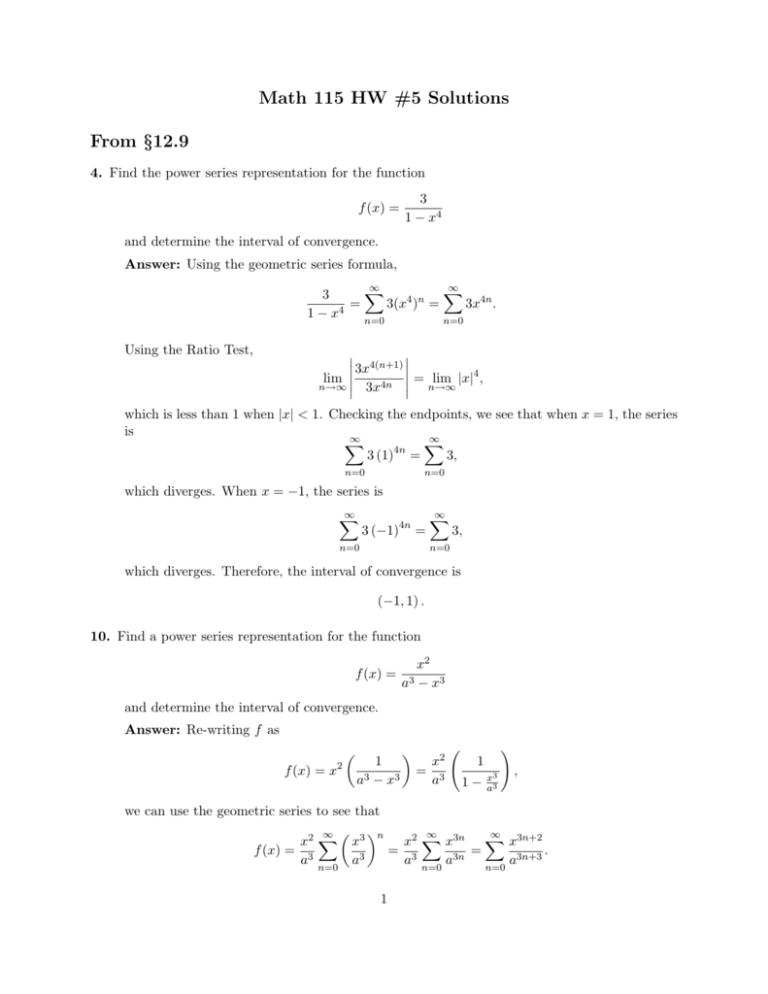
Math 115 HW #5 Solutions From §12.9 4. Find the power series representation for the function f (x) = 3 1 − x4 and determine the interval of convergence. Answer: Using the geometric series formula, ∞ ∞ n=0 n=0 X X 3 4 n = 3(x ) = 3x4n . 1 − x4 Using the Ratio Test, 3x4(n+1) lim = lim |x|4 , n→∞ n→∞ 3x4n which is less than 1 when |x| < 1. Checking the endpoints, we see that when x = 1, the series is ∞ ∞ X X 3 (1)4n = 3, n=0 n=0 which diverges. When x = −1, the series is ∞ X 3 (−1)4n = n=0 ∞ X 3, n=0 which diverges. Therefore, the interval of convergence is (−1, 1) . 10. Find a power series representation for the function f (x) = x2 a3 − x3 and determine the interval of convergence. Answer: Re-writing f as f (x) = x2 1 3 a − x3 x2 = 3 a ! 1 1− x3 a3 , we can use the geometric series to see that n ∞ ∞ ∞ x2 X x3 x2 X x3n X x3n+2 f (x) = 3 = 3 = . a a3 a a3n a3n+3 n=0 n=0 1 n=0 Using the Ratio Test, 3(n+1)+2 x 3(n+1)+3 |x|3 lim a x3n+2 = 3 , n→∞ a 3n+3 a which is less than 1 when |x| < a. Checking the endpoints, when x = a, the series is ∞ X 1 = , a ∞ X a3n+2 n=0 a3n+3 n=0 which diverges. When x = −a, the series is ∞ X (−a)3n+2 n=0 = a3n+3 ∞ X n=0 1 (−1)3n+2 , a which also diverges. Therefore, the interval of convergence is (−a, a). 16. Find a power series representation for the function f (x) = x2 (1 − 2x)2 and determine the radius of convergence. Answer: Write f (x) as f (x) = x2 Therefore, f (x) = x2 ∞ X n(2x)n−1 = x2 n=1 1 (1 − 2x)2 ∞ X . 2n−1 nxn−1 = n=1 ∞ X 2n−1 nxn+1 . n=1 Using the Ratio Test, n 2 (n + 1)xn+2 n+1 n+1 = 2|x| lim = 2|x|, lim n−1 n+1 = lim 2|x| n→∞ n→∞ n→∞ 2 nx n n which is less than 1 when |x| < 1/2. Therefore, the radius of convergence is 1/2. 24. Evaluate the indefinite integral Z ln(1 − t) dt t as a power series. What is the radius of convergence? Answer: From Example 6, we know that the power series for ln(1 − t) is ∞ X tn t2 t3 −t − − − . . . = − . 2 3 n n=1 2 Therefore, the series for 1 t −t − ln(1−t) t is ∞ X t2 t3 t t2 tn − − . . . = −1 − − − . . . = − . 2 3 2 3 n+1 n=0 Therefore, Z Z ∞ n X t ln(1 − t) t2 t2 t3 t −1 − − − . . . dt = C − t − − − . . . = C − . dt = t 2 3 4 9 n2 n=1 Using the Ratio Test, n+1 t (n+1)2 n2 lim tn = |t| lim 2 = |t|, n→∞ n→∞ n + 2n + 1 n2 so the radius of convergence is 1. From §12.10 8. Find the Maclaurin series for f (x) = cos 3x using the definition of a Maclaurin series. Also find the associated radius of convergence. Answer: We compute the first few derivatives: f 0 (x) = −3 sin 3x f 00 (x) = −9 cos 3x f 000 (x) = 27 sin 3x f (4) (x) = 81 cos 3x .. . Therefore, f (0) = 1 f 0 (0) = 0 f 00 (0) = −9 f 000 (0) = 0 f (4) (0) = 81 .. . So, by the definition of the Maclaurin series, ∞ X 9 81 32n 2n f 00 (0) 2 f (x) = f (0) + f (0)x + x + . . . = 1 − x2 + x4 − . . . = (−1)n x . 2! 2 4 (2n)! 0 n=0 3 Using the Ratio Test, 32n+2 2n+2 x (−1)n+1 (2n+2)! 32 9 lim = lim |x|2 = |x|2 lim = 0, 2n 2 3 n→∞ n→∞ 4n + 6n + 2 (−1)n (2n)! x2n n→∞ (2n + 2)(2n + 1) so this series always converges. Therefore, the radius of convergence is ∞. 16. Find the Taylor series for f (x) = 1 x centered at a = −3. Answer: Note that f 0 (x) = − f 00 (x) = 1 x2 2 x3 6 x4 24 f (4) (x) = 5 x .. . f 000 (x) = − f (n) (x) = (−1)n n! xn+1 . Therefore, 1 3 1 f 0 (−3) = − 9 2 00 f (−3) = − 27 6 f 000 (−3) = − 81 24 (4) f (−3) = − 243 .. . f (−3) = − f (n) (3) = − n! 3n+1 . Hence, by the definition of the Taylor series, f (x) = − ∞ X (x + 3)n n=0 is the Taylor series for f (x) = 1 x centered at 3. 4 3n+1 34. Use a Maclaurin series in Table 1 to obtain the Maclaurin series for the function f (x) = x2 tan−1 x3 Answer: From Table 1, we know that the Maclaurin series for tan−1 x is −1 tan ∞ X x= (−1)n n=0 x3 x5 x7 x2n+1 =x− + − + ... 2n + 1 3 5 7 Therefore, the series for tan−1 (x3 ) is −1 tan 3 (x ) = ∞ X 3 2n+1 n (x ) (−1) n=0 2n + 1 ∞ X = (−1)n n=0 x9 x15 x21 x6n+3 = x3 − + − + ... 2n + 1 3 5 7 In turn, this means that the series for f is x2 tan−1 (x3 ) = x2 ∞ X ∞ (−1)n X x6n+5 x11 x17 x23 x6n+3 = (−1)n = x5 − + − + ... 2n + 1 2n + 1 3 5 7 n=0 n=0 48. Evaluate the indefinite integral Z ex − 1 dx x as an infinite series. Answer: The Maclaurin series for ex is ex = ∞ X xn n=0 n! =1+x+ x2 x3 + + ..., 2! 3! so the series for the numerator is ∞ X x2 x3 xn x2 x3 x + + ... − 1 = x + + + ... = . e −1= 1+x+ 2! 3! 2! 3! n! n=1 In turn, this means the series for the integrand is ∞ ∞ n=1 n=1 1 X xn X xn−1 x x2 = =1+ + + ... x n! n! 2! 3! Therefore, we can integrate term-by-term to get Z ∞ X xn ex − 1 x2 x3 dx = C + x + + + ... = C + x 2 · 2! 3 · 3! n · n! n=1 56. Use series to evaluate the limit lim x→0 1 − cos x . 1 + x − ex 5 Answer: Using the Maclaurin series for cos x we can write the numerator as the series x2 x4 x6 x2 x4 x6 + − + ... = − + − .... 1 − cos x = 1 − 1 − 2! 4! 6! 2! 4! 6! Using the Maclaurin series for ex , we can write the denominator as x2 x3 x2 x3 x 1+x−e =1+x− 1+x+ + + ... = − − − ... 2! 3! 2! 3! Therefore, 2 4 x x 1 − cos x 2! − 4! + . . . = lim lim 2 3 x→0 − x − x − . . . x→0 1 + x − ex 2! 3! Dividing both numerator and denominator by x2 , this is equal to 2 1 2! 1 − x + ... lim 1 4!x = 2!1 = −1 x→0 − − − 2! 2! 3! − . . . 68. Find the sum of the series 1 − ln 2 + (ln 2)2 (ln 2)3 − + ... 2! 3! Answer: Notice that e− ln 2 = 1 − ln 2 + (ln 2)2 (ln 2)3 − + ... 2! 3! is just the given series, so the sum of the series is e− ln 2 = 1 eln 2 1 = . 2 From §12.11 16. (a) Approximate f (x) = sin x by a Taylor polynomial with degree 4 at the number π/6 Answer: The first four derivatives of f are f 0 (x) = cos x f 00 (x) = − sin x f 000 (x) = − cos x f (4) (x) = sin x 6 so we have f (π/6) = 1/2 √ f 0 (π/6) = 3/2 f 00 (π/6) = −1/2 √ f 000 (π/6) = − 3/2 f (4) (π/6) = 1/2. Therefore, the degree 4 Taylor polynomial for f at π/6 is √ √ 1 3 1 3 1 2 + (x − π/6) − (x − π/6) − (x − π/6)3 + (x − π/6)4 . 2 2 2 · 2! 2 · 3! 2 · 4! (b) Use Taylor’s Inequality to estimate the accuracy of the approximation f (x) = T4 (x) when x lies in the interval 0 ≤ x ≤ π/3. Answer: When 0 ≤ x ≤ π/3, Taylor’s Inequality says that the remainder R4 (x) is bounded by M |x − π/6|5 |R4 (x)| ≤ 5! where M is an upper bound on f (5) in this interval. Since f (5) (x) = cos x and since 1 ≤ cos x ≤ 1 2 for all x between 0 and π/3, we can pick M = 1. Therefore, 1 1 |R4 (x)| ≤ |x − π/6|5 = |x − π/6|5 . 5! 120 When 0 ≤ x ≤ π/3, the quantity |x − π/6| ≤ π/6, so 1 1 π5 |x − π/6|5 ≤ (π/6)5 = ≈ 0.000328 240 120 120 · 7776 is the worst the error could possibly be on this interval. 7 (c) Check your result in (b) by graphing |R4 (x)|. Answer: 4⋅10-4 3.2⋅10-4 2.4⋅10-4 1.6⋅10-4 8⋅10-5 0 0.25 0.5 0.75 1 35. If a water wave with length L moves with velocity v across a body of water with depth d, as in the figure, then gL 2πd tanh v2 = 2π L p (a) If the water is deep, show that v ≈ gL/(2π). Answer: As u → ∞, tanh u → 1, so, when the water is very deep, v2 ≈ 8 gL , 2π meaning that r v≈ gL , 2π as desired. √ (b) If the water is shallow, use the Maclaurin series for tanh to show that v ≈ gd. (Thus in shallow ater the velocity of a wave tends to be independent of the length of the wave.) Answer: The first few derivatives of f (x) = tanh x are f 0 (x) = sech 2 x f 00 (x) = −2 sech x sech x tanh x = −2 sech 2 x tanh x f 000 (x) = −4 sech x sech x tanh x tanh x − 2 sech 2 x sech 2 x = −4 sech 2 x tanh2 x − 2 sech 4 x Therefore, f (0) = tanh 0 = 0 f 0 (0) = sech 2 0 = 1 f 00 (0) = −2 sech 2 0 tanh 0 = 0 f 000 (0) = −4 sech 2 0 tanh2 0 − 2 sech 4 0 = −2 Hence, tanh x = x − x3 + ... 3 This gives a Maclaurin series for v 2 : ! 2πd 3 2πd − L + ... L 3 gL 2πd 3 = gd − + ... 6π L gL v2 = 2π When d is small, 2πd L is also small and higher powers of it are even smaller. Therefore, the first term above gives a good approximation for v 2 when d is small. Thus, p v ≈ gd. (c) Use the Alternating Series Estimation Theorem to show that if L > 10d, then the estimate v 2 ≈ gd is accurate to within 0.014gL. Answer: The error is no bigger than the first unused term in the series: gL 2πd 3 . |error| ≤ 6π L When L > 10d, the right hand side (and, thus, the error) is smaller than gL 2πd 3 gL π 3 π3 π2 = = gL = gL ≈ 0.013gL 6π 10d 6π 5 6π · 53 750 9


